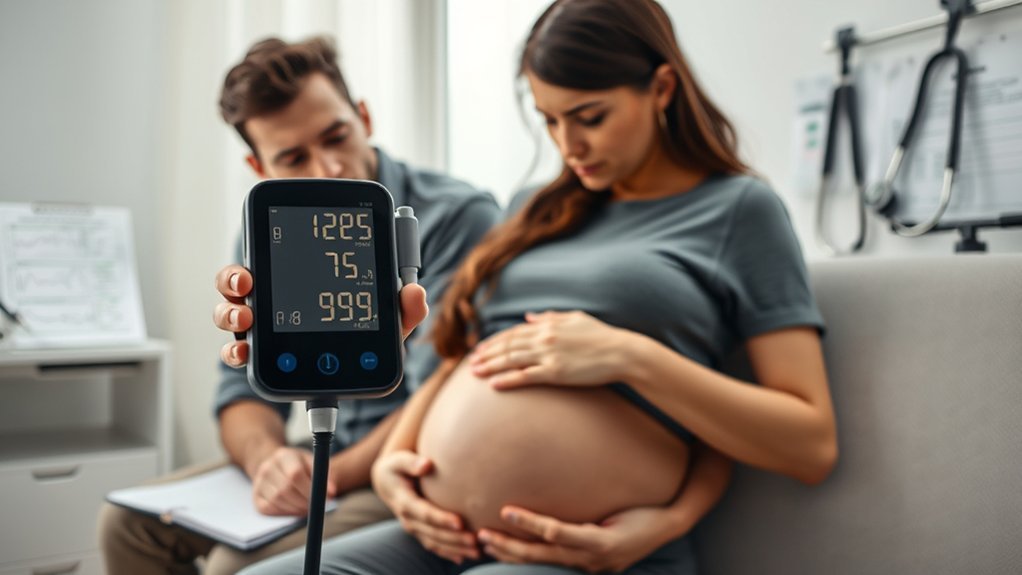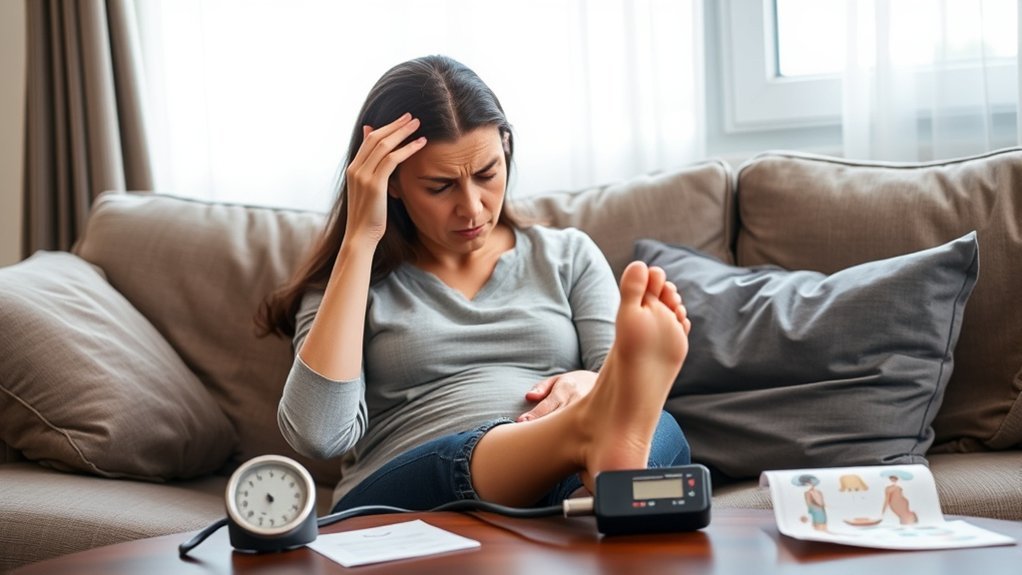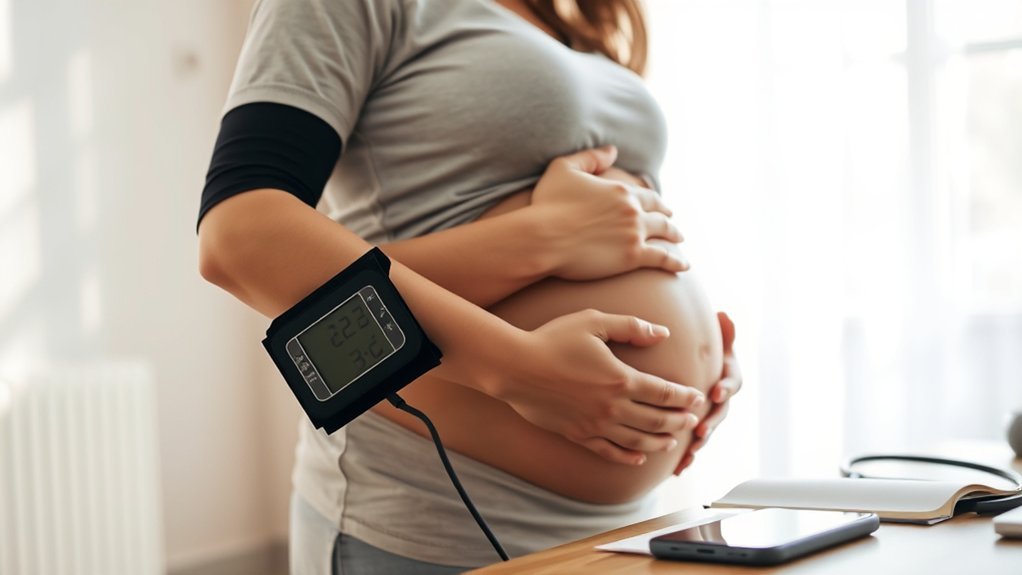Preeclampsia can be a silent threat, lurking in the shadows of pregnancy while also presenting clear warning signs. Knowing when to call a doctor is essential for your health and your baby’s well-being. High blood pressure, severe headaches, and sudden swelling can all indicate this serious condition. What you do next could make a significant difference in your pregnancy outcome. Understanding these symptoms is the first step toward protecting yourself and your child.
Understanding Preeclampsia: What It Is and Why It Matters

Preeclampsia is a serious pregnancy-related condition that typically develops after the 20th week of gestation, and it affects both the mother and the fetus.
It’s characterized by high blood pressure and potential organ dysfunction, often involving the kidneys and liver. Understanding this condition is vital because it can lead to severe complications, including eclampsia, which involves seizures, and placental abruption, where the placenta detaches from the uterus prematurely.
If you develop preeclampsia, it may result in restricted fetal growth or preterm birth. Monitoring blood pressure and protein levels in urine during prenatal visits is essential for early detection.
Common Symptoms to Watch For

When monitoring your health during pregnancy, it’s essential to recognize the common symptoms of preeclampsia. High blood pressure, typically over 140/90 mmHg, is a key indicator.
Recognizing high blood pressure over 140/90 mmHg is crucial for monitoring preeclampsia during pregnancy.
You might also notice protein in your urine, which can indicate kidney issues. Other symptoms include severe headaches that don’t respond to usual pain relief, visual disturbances such as blurred vision or flashes of light, and sudden weight gain.
You may experience abdominal pain, particularly in the upper right quadrant, and nausea or vomiting.
It’s vital to stay vigilant; if you experience any of these symptoms, reach out to your healthcare provider immediately. Early detection can considerably impact your health and that of your baby.
When Swelling Becomes Concerning

Swelling during pregnancy can be normal, but it’s essential to recognize when it becomes concerning.
Pay attention to areas like your hands, face, and feet, and monitor the timing and severity of the swelling.
If you notice rapid or excessive swelling, it’s important to consult your doctor promptly.
Normal vs. Abnormal Swelling
Although some degree of swelling is common during pregnancy, distinguishing between normal and abnormal swelling is essential for your health.
Normal swelling typically occurs in the feet, ankles, and legs, especially after long periods of standing or during hot weather. This swelling usually resolves with rest and elevation of the legs.
In contrast, abnormal swelling may be sudden, severe, or accompanied by other symptoms such as headaches, visual disturbances, or abdominal pain.
If you notice swelling in your hands or face, or if it occurs rapidly, it’s vital to contact your healthcare provider.
Recognizing these differences can help you address potential complications early, ensuring the safety of both you and your baby.
Stay vigilant; your health is paramount.
Areas of Concern
While most swelling during pregnancy is manageable, certain signs should raise concern. If you experience sudden swelling in your face, hands, or feet, it could indicate a serious issue.
Additionally, swelling accompanied by severe headaches, visual disturbances, or abdominal pain warrants immediate attention. Pay attention to rapid weight gain—more than 2 pounds in a week—or any swelling that persists or worsens despite rest and elevation.
Elevated blood pressure readings may also be a red flag. Don’t ignore these symptoms; they can signal the onset of preeclampsia, a potentially dangerous condition.
Always consult your healthcare provider if you’re unsure about your symptoms or if they change unexpectedly. Early intervention can greatly improve outcomes for you and your baby.
Timing for Doctor Visit
When should you seek medical advice about swelling during pregnancy?
If you notice sudden or severe swelling in your hands, face, or feet, it’s essential to contact your doctor immediately. Swelling that occurs rapidly, especially if accompanied by high blood pressure, headaches, or visual disturbances, can indicate preeclampsia, a serious condition.
You should also reach out if swelling persists or worsens over a few days, as this may signal potential complications. While mild swelling is common, changes in your body should always be monitored.
Keeping a record of any concerning symptoms can help your healthcare provider assess your situation more accurately. Remember, it’s better to err on the side of caution when it comes to your health and your baby’s well-being.
The Importance of Monitoring Blood Pressure
Monitoring your blood pressure is essential in identifying the risk factors associated with preeclampsia.
Regular checks allow you to track changes and catch any concerning elevations early.
Understanding blood pressure basics empowers you to take proactive steps for your health during pregnancy.
Blood Pressure Basics
Blood pressure plays a critical role in evaluating your overall health, especially during pregnancy. Monitoring your blood pressure helps detect potential complications, such as preeclampsia, which can threaten both you and your baby.
Normal blood pressure ranges from 90/60 mmHg to 120/80 mmHg. Elevated readings, typically 140/90 mmHg or higher, warrant immediate attention. You should measure your blood pressure regularly, ideally at home, to establish a baseline.
If you notice sudden spikes or persistent high readings, contact your healthcare provider. Early intervention can greatly reduce risks.
Risk Factors Identification
Elevated blood pressure can signal underlying risk factors for preeclampsia that you should be aware of during your pregnancy. Certain factors increase your risk, including a history of high blood pressure, obesity, and a family history of preeclampsia.
Age also plays a role; women over 35 or those under 20 may be at higher risk. Additionally, if you’re carrying multiple babies, your risk increases.
Conditions like diabetes, kidney disease, or autoimmune disorders further heighten the likelihood of developing preeclampsia.
It’s essential to recognize these risk factors early, as they can guide your healthcare provider in monitoring you more closely throughout your pregnancy. Understanding these risks empowers you to advocate for your health and your baby’s wellbeing.
Regular Monitoring Importance
To guarantee a healthy pregnancy, keeping track of your blood pressure is vital, especially if you have risk factors for preeclampsia. Regular monitoring allows you to detect any significant changes early, enabling prompt intervention.
Elevated blood pressure can lead to serious complications for both you and your baby, including organ damage and fetal distress. If you notice readings above 140/90 mmHg, it’s important to contact your healthcare provider immediately. They may recommend more frequent check-ups or additional tests to assess your condition.
Additionally, maintaining a healthy lifestyle—through proper nutrition, hydration, and stress management—can help regulate your blood pressure. Always communicate any concerns or symptoms to your doctor to guarantee a safe and healthy pregnancy journey.
Other Warning Signs You Shouldn’t Ignore
What subtle signs might indicate a serious condition like preeclampsia? You shouldn’t ignore sudden weight gain, particularly over two pounds in a week, as it may signal fluid retention.
Severe headaches that don’t respond to usual remedies can also be a warning sign. Additionally, watch for visual disturbances, such as blurriness or seeing spots, which may indicate increased blood pressure.
Severe headaches and visual disturbances can signal increased blood pressure; don’t overlook these warning signs.
You might notice upper abdominal pain, especially under the ribs, alongside nausea or vomiting. Swelling in your hands and face is another symptom to monitor closely.
If you experience any of these signs, it’s essential to contact your healthcare provider. Early intervention can be significant in managing preeclampsia and protecting both you and your baby.
Steps to Take If You Suspect Preeclampsia
If you suspect preeclampsia, taking immediate action is essential for your health and that of your baby.
Start by monitoring your symptoms closely; note any sudden swelling, severe headaches, or visual disturbances. Contact your healthcare provider right away to discuss your concerns. They may recommend an office visit for blood pressure checks and urine tests to assess protein levels.
If symptoms worsen or you experience severe abdominal pain, seek emergency care immediately. Avoid self-diagnosing or delaying treatment, as preeclampsia can lead to serious complications.
Maintain open communication with your healthcare team, and follow their guidance on managing your condition. Your prompt action can greatly impact your pregnancy outcome and overall well-being.
Frequently Asked Questions
Can Preeclampsia Occur After Childbirth?
Yes, preeclampsia can occur after childbirth, known as postpartum preeclampsia. Symptoms may arise within days to weeks following delivery. If you experience sudden headaches, vision changes, or swelling, contact your healthcare provider immediately.
How Is Preeclampsia Diagnosed?
Preeclampsia’s diagnosed through monitoring blood pressure and checking for protein in your urine. Your doctor may conduct blood tests and evaluate other symptoms to confirm the condition and determine the best course of action.
What Are the Long-Term Effects of Preeclampsia?
Preeclampsia can lead to long-term effects like high blood pressure, heart disease, and kidney issues. Isn’t it essential to monitor your health post-pregnancy? Regular check-ups can help you manage these potential complications effectively.
Can Diet or Lifestyle Changes Prevent Preeclampsia?
Yes, adopting a balanced diet, maintaining a healthy weight, exercising regularly, and managing stress can potentially reduce the risk of preeclampsia. However, it is crucial to consult your healthcare provider for personalized recommendations and monitoring.
Are There Any Risk Factors for Developing Preeclampsia?
Yes, certain risk factors can increase your chances of developing preeclampsia. These include being a first-time mom, having high blood pressure, obesity, diabetes, or a family history of the condition. Regular monitoring is essential.
Conclusion
In traversing the uncertain waters of pregnancy, being vigilant about preeclampsia is like keeping a lighthouse in view. By recognizing the warning signs—high blood pressure, severe headaches, and unusual swelling—you can steer clear of potential dangers. If you notice any of these red flags, don’t hesitate to reach out to your healthcare provider. Your awareness and prompt action can safeguard both your health and your baby’s, ensuring you both sail smoothly toward the joys of parenthood.
